“We’ve got four barrels full… four barrels of fun!” – Chip Walton
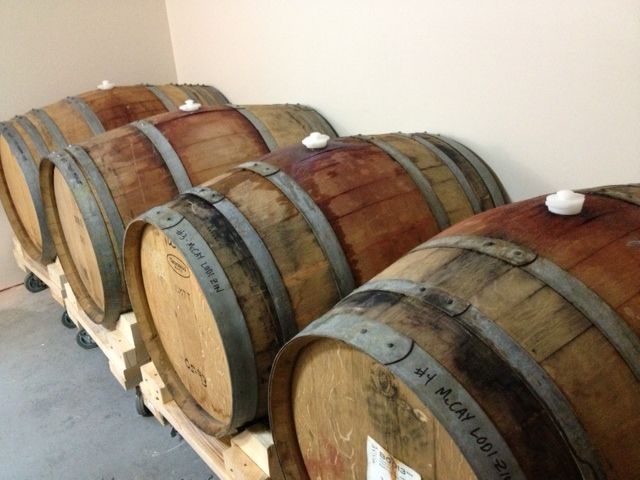
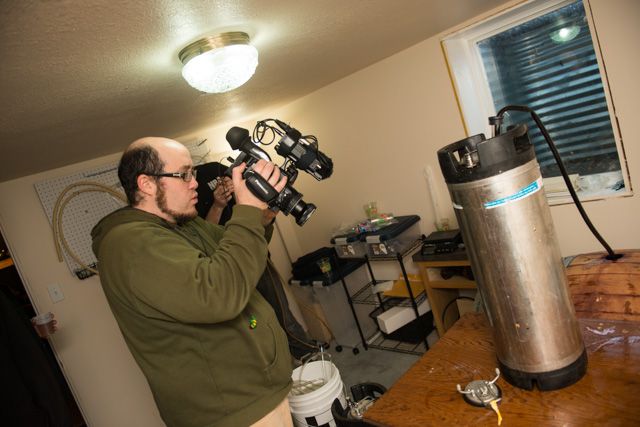 Ok so maybe that wasn’t an exact quote. We did however have Chip Walton of Chop & Brew and Summit Brewing Co. fame (formerly of BrewingTV and Northern Brewer) join us to video archive the day as members of the NBA filled barrels from Barrel Project 2.0. Chip’s will be using this footage for an upcoming webisode of Chop & Brew! Chip does great work so we’re very excited to see what he puts together.
Ok so maybe that wasn’t an exact quote. We did however have Chip Walton of Chop & Brew and Summit Brewing Co. fame (formerly of BrewingTV and Northern Brewer) join us to video archive the day as members of the NBA filled barrels from Barrel Project 2.0. Chip’s will be using this footage for an upcoming webisode of Chop & Brew! Chip does great work so we’re very excited to see what he puts together.
Barrel project participation is open to NBA members only. JOIN OUR HOMEBREW CLUB HERE to participate in future fill days!
Here’s how the transfer schedule panned out:
- Rye Saison (with multiple Brett strains) – filled 2/16/13 as all participants had their beers ready early
- Russian Imperial Stout (clean beer) – filled 2/23/13
- Wee Heavy / Scotch Ale (clean beer) – filled 2/23/13
- Flanders Red (sour beer) – filled 2/23/13
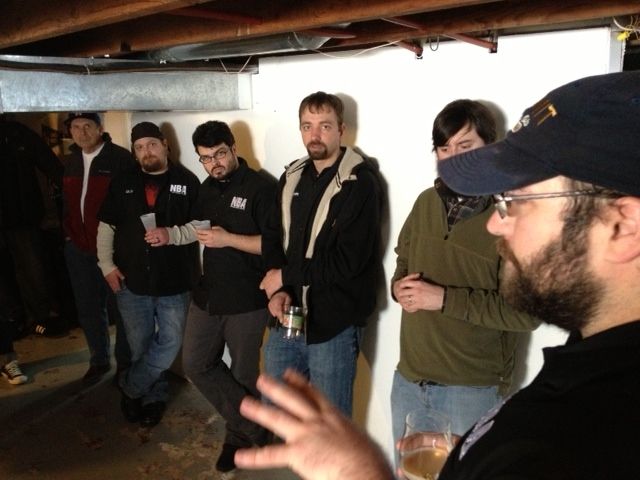 We used the big transfer day on the 23rd as our February club meeting, encouraging all members to attend whether they’d brewed beers for the barrels or not. After going over a few club business items, we heard from Casey Holley, owner of the barrels who told the story of how he acquired them and facilitated their journey from northern California to chilly Minnesota this past fall. Then Aaron De Boer, owner of De Boer Cellars where the barrels will age over the coming year, took us through a brief education session on barrel re-fermentation and described the fill process we would be executing. Then… we got to work!
We used the big transfer day on the 23rd as our February club meeting, encouraging all members to attend whether they’d brewed beers for the barrels or not. After going over a few club business items, we heard from Casey Holley, owner of the barrels who told the story of how he acquired them and facilitated their journey from northern California to chilly Minnesota this past fall. Then Aaron De Boer, owner of De Boer Cellars where the barrels will age over the coming year, took us through a brief education session on barrel re-fermentation and described the fill process we would be executing. Then… we got to work!
First step was to pump out the acid wash from the barrels.
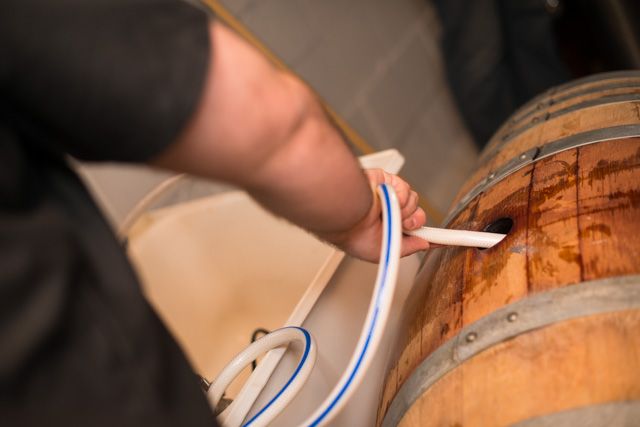
Next the barrels were wheeled back into the cellar room for filling. Very glad to have some nice barrel racks custom-build by members of the club a few months ago. These suckers weigh 600 lbs. when filled!
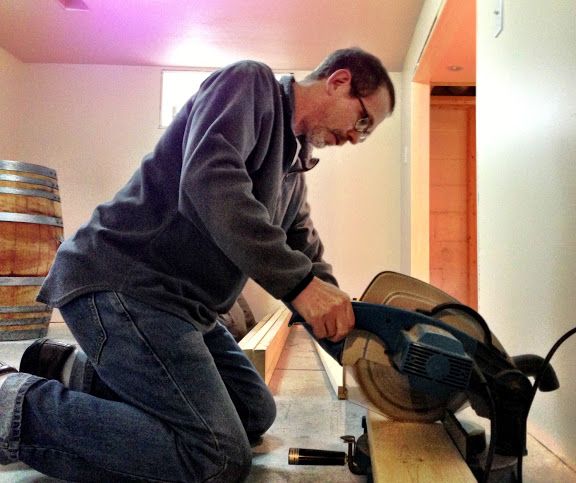
Aaron’s cellar will stay between 50 and 65 degrees as the seasons change and these beers age.
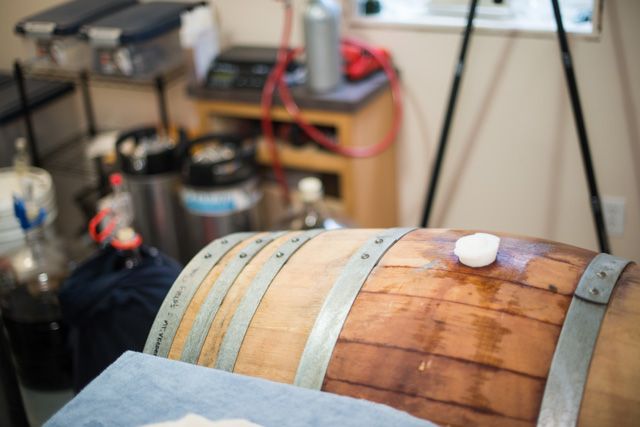
Over 200 gallons of beer were transferred into these four barrels over the course of two weekends.
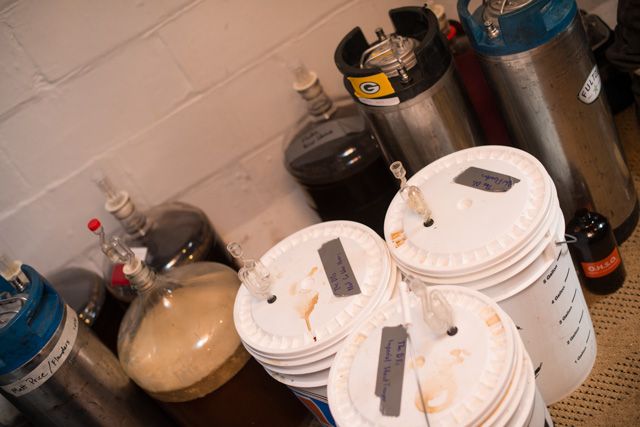
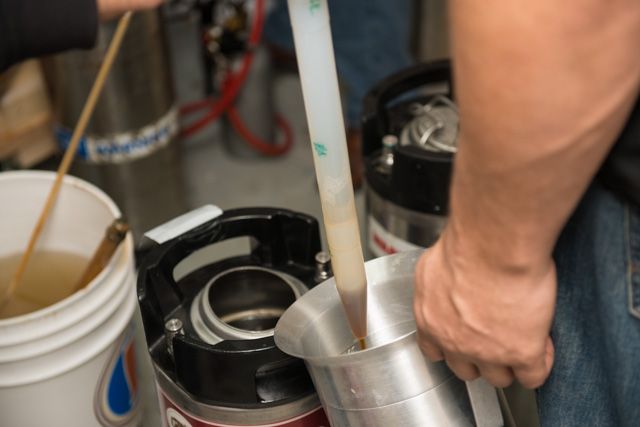 A “rigorous” taste-testing and voting session was performed by a pannel of judges for each barrel. Really, we let all beers in as long as they didn’t have overt off-flavors. Of all the batches, only one got two thumbs down and thus was omitted from one of the barrels. We were fortunate enough to have such loose standards only because we have some really great brewers in this club!
A “rigorous” taste-testing and voting session was performed by a pannel of judges for each barrel. Really, we let all beers in as long as they didn’t have overt off-flavors. Of all the batches, only one got two thumbs down and thus was omitted from one of the barrels. We were fortunate enough to have such loose standards only because we have some really great brewers in this club!
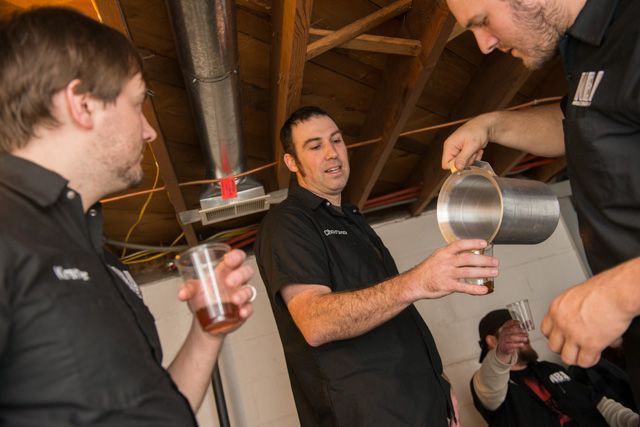

Once a batch received two thumbs up from members of the tasting pannel, beers that arrived in kegs were pushed into the barrels via CO2 in order to minimize oxygen pickup while carboys were syphoned in per usual.
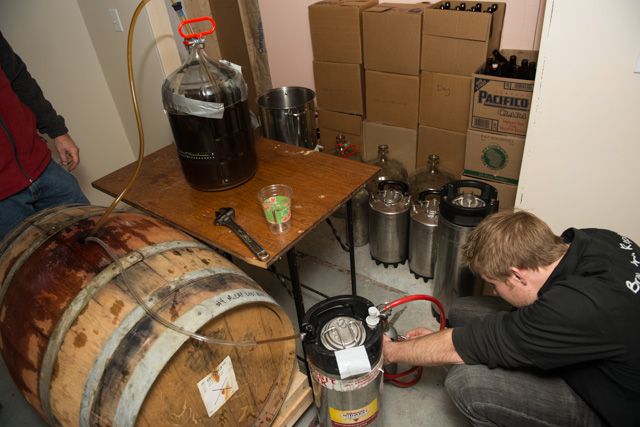
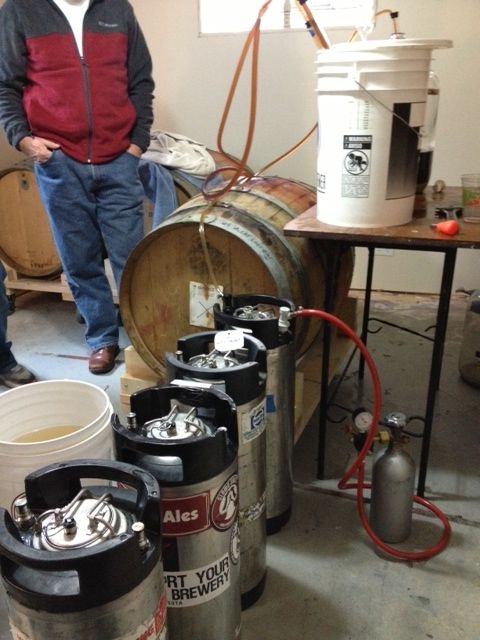
Roughly a third of the Flanders Red batches were inoculated with Brett, Pedio, Lacto and Sacc in primary and the rest were brewed clean with just normal Sacc brewing yeast. For the carboys of Flanders that had been funked in primary, we purposefully stirred up the yeast cakes at the bottom of the carboys and syphoned in the slurry into the barrel to get the Flanders barrel as funktified as possible. Most of these yeast cakes were primarily Roselare or White Labs lambic blends, but one batch in particular brewed by barrel project coordinator Nick Pederson included East Coast Yeast 20 (ECY-20) Bug Country, which has 20 different types of yeast, Brett, lactobacillus, pediococcus, wild cider yeast, sherry yeast and others. Nick’s batch also had ECY-o2 Flemish Blend and a yeast cake from Nick’s naturally fermented local cider, so some local yeast made it into the barrel! The Flanders is going to be FUNK-EEEE.
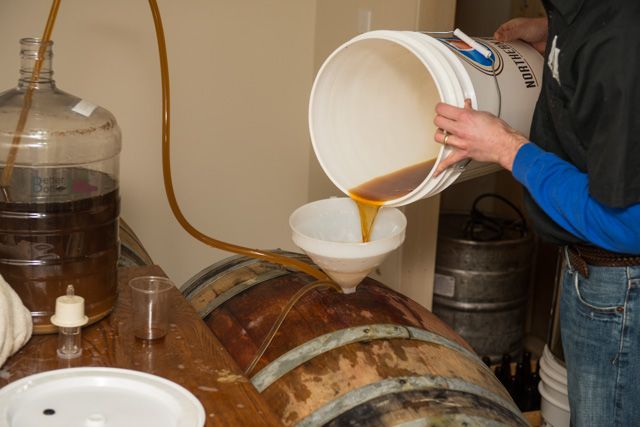
It should go without saying, but YES we used completely separate tubing to transfer the Flanders beers soured in primary than all other clean beers filling the barrels on this day.
Below is a picture of the Rye Saison barrel getting inoculated with a Brett starter Nick had put together back on the 2/16 fill day. A few strains of Brett that went into the Saison barrel were isolated and propagated from bottles of Cantillon by a yeast rancher based in Brooklyn, NY. We choose the ones called C2 and C3 because they tasted like strawberry, pineapple, pears, apples and were really fruity. C3 had a bit of barnyard funk as well. Check out BKYeast’s blog post for characteristics of the strains we used written by the yeast rancher himself.
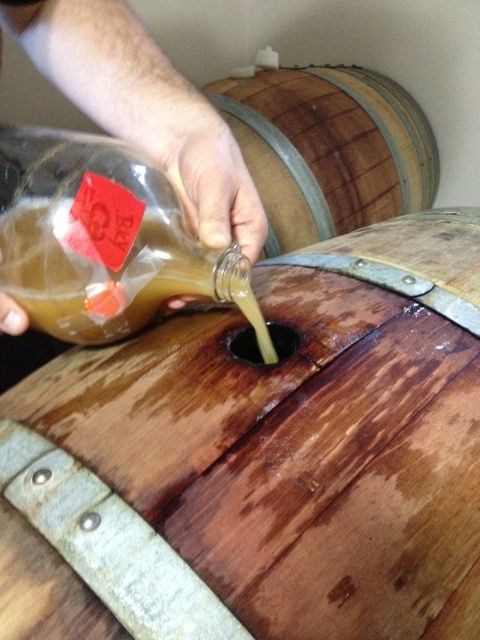
One thing to remember about De Boer Cellars is to watch your head if you’re even mildly tall. ESPECIALLY the light in the middle of the cellar room…
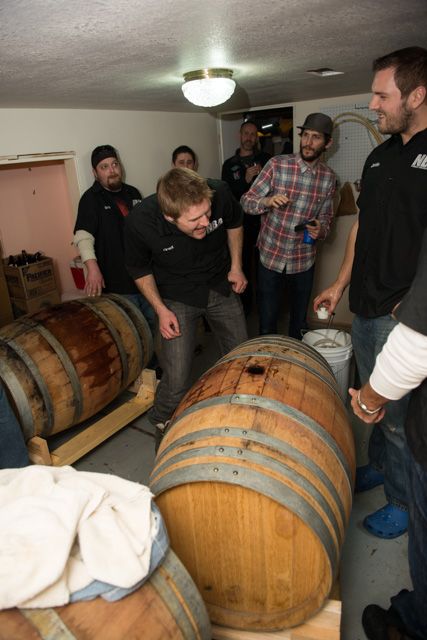
With such a huge target OG, it was apparent most everyone contributing to the Russian Imperial Stout barrel dealt with an extremely vigorous fermentation, often blowing off the carboy. Lots of crusty fermenters in the house on fill day!
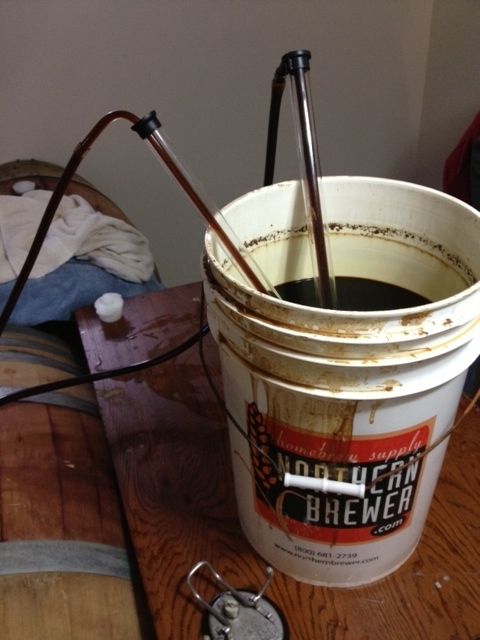
So many hoses penetrating the barrel… so many jokes to be made…
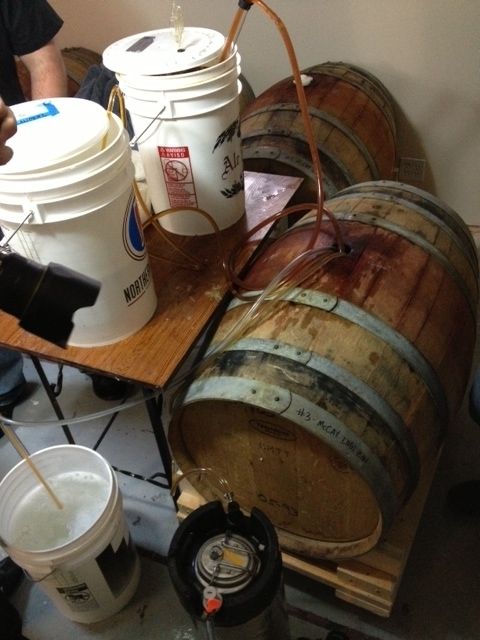
And of course there was some barrel wrangling to be done, a very necessary step in the fill process. Sort of like christening a ship with Champagne for good luck, but classier.
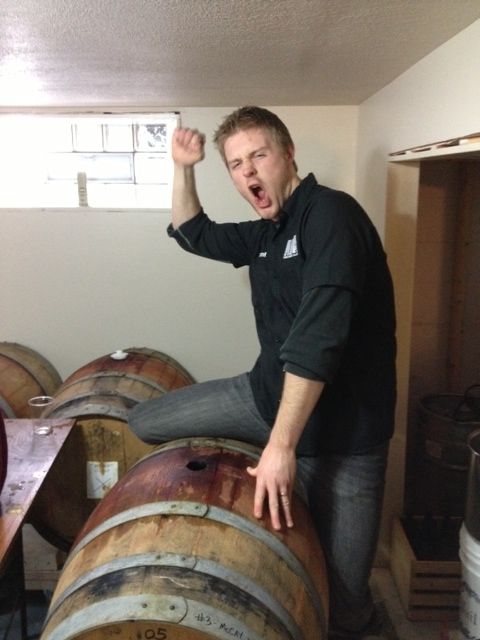
In all seriousness, we were diligent in sterilizing these barrels but you never know what could happen so it’s best to send them on their way into secondary fermentation with fingers crossed. Granted two of the batches are intended to turn out funky, but brewers for the two clean barrels are making a serious leap of faith that the beer will stay clean and not turn into a sour Russian Imperial Stout or Wee Heavy. Of course, some might say that wouldn’t be the worst thing ever… Either way, our beers are in the hands of the barrels now. Clearly, in barrels we trust.
Once all the batches were syphoned into each barrel, we purged the headspace with CO2 and bunged the hole!
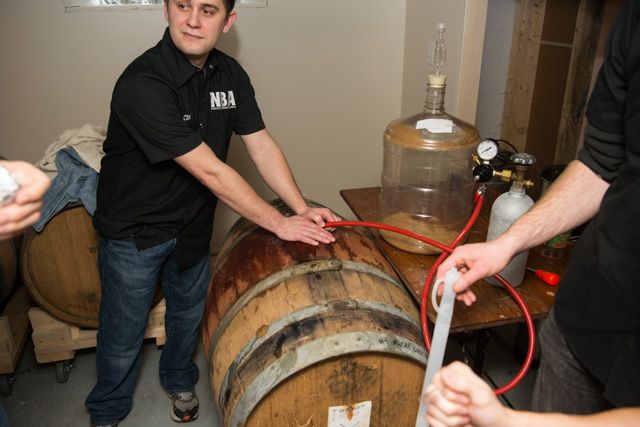
We used special vinters’ airlocks that don’t require liquid. These will allow the barrels to off-gas in the coming days as the beer settles and will allow the release of CO2 that will result from secondary fermentation activity in the barrels.
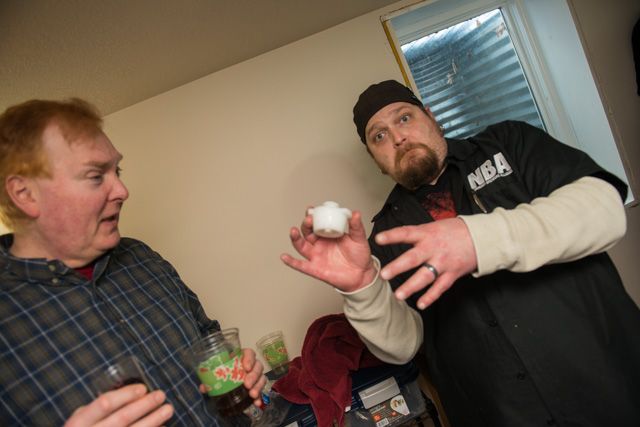
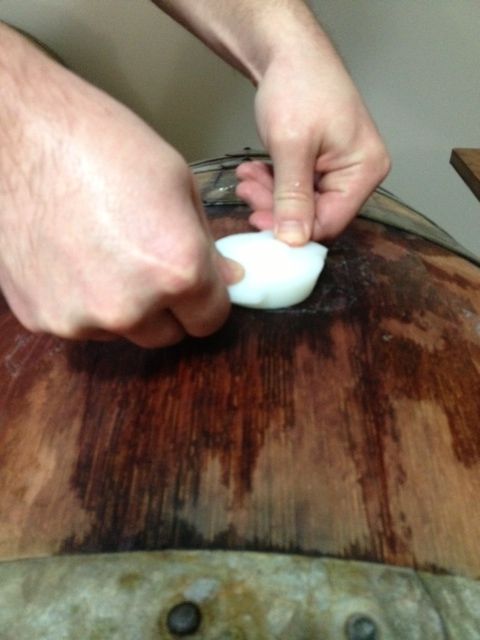
28 different brewers – nearly half the club – occupied 55 spots to brew enough beer over the past month to fill FOUR 59 gallon wine barrels. What other homebrew club do you know of that could pull off something like this? If you’re thinking about joining a homebrew club, JOIN THE NBA! Take advantage of great discounts, personal feedback on your beers and your process, fun club-only events and competitions and of course FREAKING SWEET PROJECTS AND EXPERIMENTS! Upcoming awesomeness inclues a yeast experiment and single-hop experiment with Northgate Brewing, events at Northern Brewer and Summit Brewing Co., emptying and filling our club’s first barrel that has been souring since April 2012, club-only competitions and tap room takeovers! No one else can offer you what this club can. Get in on it.
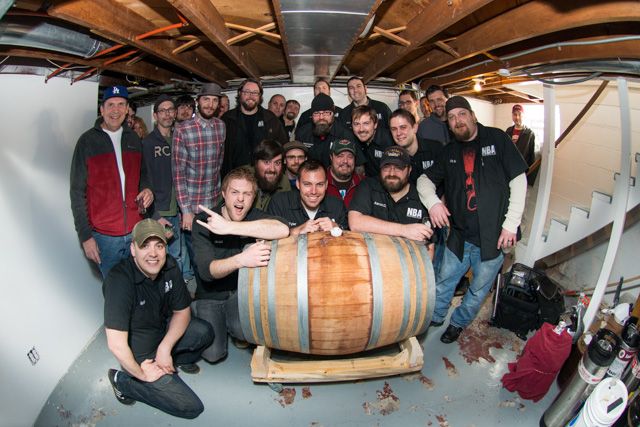
Barrel project 2.0 fill day was a great experience, an opportunity for Twin Cities homebrewers to come together and contribute to something much bigger than they could ever accomplish on their own. Cheers from the NBA!
It was AWESOME to be a part of NBA’s day! Thanks for having me and the Chop & Brew camera over for it.
Chip, I gots to see some of that video and live vicariously! Wish I coulda been there. Let’s hang out soon!
Nick
YES! Sour blending 2.0?
It pleases me to hear that people use the strains I isolated. Have you guys made anything else with those strains? I still have received a very limited response in terms of the characteristics they impart to the beer and I’m always on the lookout for some new ones. C1 seems to be popular amongst those who gave me feedback. Please let me know if you have anything.
Cheers!
I’d been meaning to reach back out to you. I got your C2, C3, and the issolated WY Berliner brett from you, or actually from Brooklyn homebrew back in November! Thanks so much for doing that man. VERY COOL! I ended up putting those samples into about 3/4’s gallon each of 1032 wort (Table Saison recipe). I definitely used too much wort for a first “step up”, but I wasn’t too worried about it. I ended up bottling each of those into 750 ml bottles and bottle conditioned. (When I bottled them I lightly poured them directly into the bottles from the 1 gallon jugs so there was some definite oxygenation but it was the only method I had).
As you know, our club just filled up 4 Wine barrels and one of the barrels is a Rye Saison with Brett. I originally was going to use Brett Drie, but decided that I’d have my club taste “your” brett strains, and see if they felt they would be complementary to the base beer.
Here are our tasting notes – These were 100% brett ferments at about 68 degree ambiant temperatures (underpitched)
The C2 was described as strawberries, bubblegum, green apple, pear with a little wet sock/ good cheese and slight vinegar. Finished fairly dry (didn’t get a reading though)
The C3 beer was sweeter than C2 in aroma and flavor (probably from underpitching, or maybe just not as voracious a 100% fermenting brett compared to C2). I saw that you found the opposite results though. Fruity and pineapple were the only descriptions for aroma. Also there was more funk on the palate.
There was no notes on the Berliner. But the crew decided that we weren’t going to use this one because it had some sourness too it. Not sure if the sourness came from my 1 gallon jug that was contaminated. The bottle that I bottled it in, or even potentially the fact that it was oxidized when I bottled it, and the oxygen and refermentation caused the Brett to produce some Acetic acid. I tasted slightly sour, and my crew didn’t want the Saison Brett to be a sour, so we decided to not use it just in case. Most of us, really like the way it tasted and it was very fruity, dry and tart.
Not great notes, but it was 15 of us sampling these. We ended up using both C2, and C3 in our barrel!!!! They liked the variety of fruit that they tasted, and the slight funk from C3. Should be a fantastic beer when we go to bottle in 3-4 months!
Please let me know if you have any other brett strains that you could ship me, and I’d love to get some of that Cascade Lacto!!!!!
Cheers,
Nick
VP and Barrel Wrangler
I just want to say it’s awesome to see that two-part conversation in the comments above.